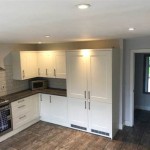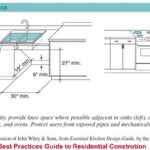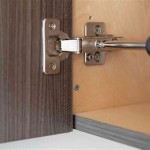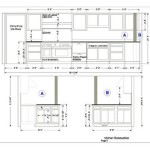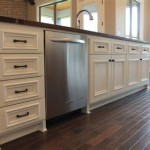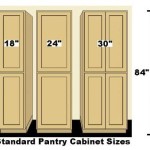```html
Kitchen Cabinet Trends: A Comprehensive Overview
Kitchen cabinets form the backbone of any kitchen design, shaping its functionality, aesthetics, and overall ambiance. Staying abreast of current kitchen cabinet trends can empower homeowners and designers to create spaces that are both stylish and practical. This article delves into the prevailing trends influencing kitchen cabinet design, covering materials, colors, styles, and technological advancements.
Color Palettes in Contemporary Kitchens
Color plays a crucial role in defining the character of a kitchen. While white cabinets have remained a perennial favorite, contemporary trends are expanding to encompass a broader spectrum of hues.
Neutral Tones: Beyond stark white, softer neutral tones such as warm grays, taupes, and greiges (gray-beige blends) are gaining traction. These colors provide a versatile backdrop that complements various design styles and allows other elements, such as countertops and backsplashes, to take center stage. Neutral cabinets create a calming and sophisticated atmosphere, which is particularly appealing in open-concept living spaces.
Earthy Greens and Blues: Inspired by biophilic design principles, earthy greens and blues are increasingly popular choices for kitchen cabinets. These colors evoke a sense of nature and tranquility, bringing the outdoors in. Sage green, forest green, and muted teal are examples of greens that are finding favor, while navy blue, slate blue, and deep teal are popular blue options. Incorporating these colors can create a calming and inviting kitchen environment.
Bold Accent Colors: While entire kitchens in bold colors may not be universally appealing, using vibrant hues as accents on island cabinets or lower cabinets is a growing trend. Colors like deep red, charcoal gray, or even a bright yellow can add visual interest and personality to the kitchen. The key lies in balancing bold accents with more neutral tones to avoid overwhelming the space.
Two-Toned Kitchens: The two-toned kitchen cabinet trend continues to evolve. Often, this involves painting upper cabinets a lighter color (like white or off-white) and lower cabinets a darker color (like gray or navy). This technique can visually ground the space and create a sense of depth. Another variation involves using different colors for the perimeter cabinets and the kitchen island, creating a focal point.
Material Innovations and Sustainability
The selection of cabinet materials impacts both the aesthetics and the longevity of the kitchen. Trends in this area revolve around durability, sustainability, and visual appeal.
Engineered Wood Products: Engineered wood products, such as plywood and MDF (medium-density fiberboard), remain popular choices for cabinet construction. These materials offer stability, resistance to warping, and a smooth surface for painting or laminating. High-quality engineered wood products are also designed to be moisture-resistant, making them suitable for the humid environment of a kitchen.
Sustainable Materials: With growing environmental awareness, sustainable cabinet materials are gaining prominence. Bamboo, reclaimed wood, and formaldehyde-free MDF are examples of eco-friendly options. Bamboo is a rapidly renewable resource, while reclaimed wood adds a unique character and reduces waste. Formaldehyde-free MDF minimizes the release of harmful chemicals into the home.
Metal Accents: Incorporating metal accents into cabinet design is a trend that adds a touch of sophistication and modernity. Metal hardware, such as pulls and knobs, is a common way to achieve this. However, some designers are also incorporating metal panels or inlays into cabinet doors for a more dramatic effect. Brushed nickel, stainless steel, and matte black are popular metal finishes.
Acrylic and Laminate Finishes: Acrylic and laminate finishes offer a durable and easy-to-clean alternative to traditional paint or wood veneer. High-gloss acrylic cabinets provide a sleek and modern look, while textured laminates can mimic the appearance of real wood or stone. These materials are scratch-resistant and moisture-resistant, making them ideal for high-traffic kitchens.
Cabinet Styles and Design Elements
Cabinet style shapes the overall aesthetic of the kitchen, ranging from traditional to contemporary.
Slab Door Cabinets: Slab door cabinets, characterized by their flat, unadorned surface, are a hallmark of modern and minimalist design. These cabinets offer a clean and streamlined look that emphasizes simplicity. Slab doors are often paired with handleless designs or minimalist hardware to maintain a sleek aesthetic.
Shaker Cabinets: Shaker cabinets, with their simple recessed panel design, remain a timeless and versatile choice. Their clean lines and understated elegance make them suitable for a wide range of kitchen styles, from traditional to transitional. Shaker cabinets can be customized with different paint colors, hardware, and countertop materials to create a unique look.
Open Shelving: Incorporating open shelving into kitchen design is a trend that promotes both functionality and visual appeal. Open shelves provide easy access to frequently used items, such as dishes and glassware, while also allowing homeowners to display decorative objects and personalize their space. Balancing open shelving with closed cabinets is key to maintaining a clutter-free and organized kitchen.
Integrated Appliances: Hiding appliances behind cabinet panels is a trend that creates a seamless and cohesive kitchen design. Integrated refrigerators, dishwashers, and even microwaves can be concealed behind custom cabinet doors, blending seamlessly into the overall cabinetry. This approach creates a clean and uncluttered look, particularly well-suited for modern and minimalist kitchens.
Handleless Cabinets: Handleless cabinets, also known as push-to-open or touch-to-open cabinets, are a growing trend in contemporary kitchen design. These cabinets eliminate the need for traditional handles or pulls, creating a sleek and minimalist aesthetic. Handleless cabinets are often used in conjunction with slab door cabinets to emphasize the clean lines and simplicity of the design. Mechanical or electronic mechanisms allow the cabinets to open with a gentle push.
Custom Storage Solutions: Maximizing storage space is a primary concern in kitchen design, leading to the increasing popularity of custom storage solutions. Pull-out shelves, drawer organizers, spice racks, and pantry systems are examples of custom storage features that can optimize space and improve organization. These features help to keep the kitchen tidy and efficient, making it easier to cook and entertain.
Technological Integration in Kitchen Cabinets
Technology is increasingly integrated into kitchen design, including cabinet functionality.
Smart Lighting: Integrating smart lighting into cabinet design allows for customized illumination options. LED strip lights can be installed under cabinets to provide task lighting, while interior cabinet lights can illuminate contents for easy access. Smart lighting systems can be controlled remotely via smartphone or voice commands, allowing homeowners to adjust brightness and color temperature to suit their needs.
Powered Drawers and Cabinets: Motorized drawers and cabinets offer convenience and accessibility, particularly for individuals with limited mobility. These systems allow cabinets and drawers to open and close automatically with the touch of a button or a voice command. This feature can be particularly useful for accessing hard-to-reach areas, such as corner cabinets or high shelves.
Integrated Charging Stations: Kitchens have become a central hub for charging electronic devices. Incorporating charging stations into cabinet design provides a convenient and discreet way to keep phones, tablets, and other gadgets powered up. These charging stations can be integrated into drawers, cabinets, or even the backsplash, keeping counters clutter-free.
Voice-Activated Controls: Voice-activated technology is increasingly used to control various aspects of the kitchen, including cabinet lighting and operation. Homeowners can use voice commands to turn on cabinet lights, open drawers, or even adjust the temperature of an integrated wine cooler. This technology allows for hands-free operation, which can be particularly useful while cooking or entertaining.
App-Controlled Functionality: Many modern kitchen appliances and features can be controlled via smartphone apps. This includes cabinet lighting, temperature controls, and even self-closing mechanisms. App control allows homeowners to monitor and adjust various aspects of their kitchen from anywhere, providing added convenience and security.
```
Latest Trends In Kitchen Cabinets And How To Get Them

Kitchen Cabinet Styles And Trends

Top 40 Kitchen Trends For 2024 That Our Editors Love

2024 Kitchen Cabinet Trends

Check Out These Kitchen Cabinet Trends For 2024 Reviewed
2024 Kitchen Trends That Are In And Out According To Designers

The Top 7 Trends In Kitchen Cabinet Design For 2024 Mainstreet Build

Trending Kitchen Cabinets Colour Schemes Of 2024 Design Cafe

13 Biggest Kitchen Design Trends In 2024 And Beyond

The Kitchen Cabinet Trend That S Set To Take Over In 2024
Related Posts

